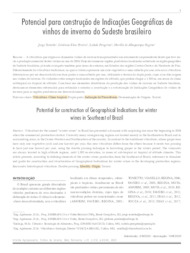Potencial para construção de Indicações Geográficas de vinhos de inverno do Sudeste brasileiro.
Potencial para construção de Indicações Geográficas de vinhos de inverno do Sudeste brasileiro.
Author(s): TONIETTO, J.; PEREIRA, G. E.; PEREGRINO, I.; REGINA, M. de A.
Summary: O Brasil apresenta grande diversidade de condições naturais nas diferentes regiões vitícolas produtoras de uvas destinadas à elaboração de vinhos. O clima é o elemento- -chave dessa diversidade, com a viticultura localizada em climas temperados, subtropicais e tropicais. Viticulture for the named ?winter wines? in Brazil has presented a dynamic with surprising rise since the beginning in 2004 when the commercial production started. Currently many winegrowing regions are located mainly in the Southeastern Brazil and in surrounding areas, in the Center-Western and Northeastern of the country. In contrast to the traditional viticulture, where grapevines have only one vegetative cycle and one harvest per year, this new viticulture differs from the others because it needs two pruning to have just one harvest per year, using the double pruning technique to harvesting grapes in the winter period. The vineyards are always located in high altitude regions, until 1,300 m elevation, in zones of sub-tropical or tropical of altitude climates. This article presents, according to defining elements of the winter wines production from the Southeast of Brazil, references to stimulate and guide for construction and structuration of Geographical Indications for winter wines in the developing production regions. Keywords: Intertropical viticulture. Double pruning. Identity. Origin. Terroir.
Publication year: 2020
Types of publication: Journal article
Unit: Embrapa Grape & Wine
Observation
Some of Embrapa's publications are published as ePub files. To read them, use or download one of the following free software options to your computer or mobile device. Android: Google Play Books; IOS: iBooks; Windows and Linux: Calibre.
Access other publications
Access the Agricultural Research Database (BDPA) to consult Embrapa's full library collection and records.
Visit Embrapa Bookstore to purchase books and other publications sold by Embrapa.

